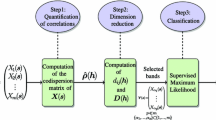Abstract
Numerous efforts have been made to study how the spatial distribution of ground surface objects controls the image semivariogram. The present paper is centered on how the histograms and semivariograms of the individual bands x and y influence the spatial variation of a simple spectral ratio u = arctan(x/y). The image histogram of each separate band is described by a proper distribution. The exponential model is used to describe the semivariograms of x and y. Taking the first derivatives of the spectral ratio u for x and y and taking into account the mathematical behavior of the histograms of bands x and y, an approximate expression for the semivariogram γ u of the spectral ratio is derived. This mathematical expression shows how the spatial variation of the spectral ratio depends on the standard deviations of the histograms, as well as the ranges of the semivariograms of x and y. Experimentation with multispectral images is then carried out and it shows that theoretical predictions agree, in qualitative terms, with real data. The results and conclusions of this paper may be useful in assessing the efficiency of various spectral band ratios and vegetation indices, which are often used in geological and environmental research (mapping of hydrothermal zones and land cover types).














Similar content being viewed by others
References
Atkinson PM (2001) Geostatistical regularization in remote sensing. In: Tate NJ, Atkinson PM (eds) Modelling scale in geographic information science. Wiley, New York, pp 237–260
Curran PJ (1988) The semivariogram in remote sensing: an introduction. Remote Sens Environ 24(3):493–507
Garrigues S, Allard D, Baret F (2007) Using first- and second–order variograms for characterizing landscape spatial structures from remote sensing imagery. IEEE Trans Geosci Remote Sens 45(6):1823–1834
Garrigues S, Allard D, Baret F, Weiss M (2006) Quantifying spatial heterogeneity at the landscape scale using variogram models. Remote Sens Environ 103(1):81–96
ILWIS 3.4 (2007) ITC
Julesz B (1962) Visual pattern discrimination. IRE Trans Inf Theory 8(2):84–92
Jensen JR (1996) Introductory digital image processing. A remote sensing perspective, 2nd edn. Prentice Hall, New Jersey
Kotsakis DD (1972) Error theory and least squares method. University of Athens (in greek), Athens
Lacaze B, Rambal S, Winkel T (1994) Identifying spatial patterns of Mediterranean landscapes from geostatistical analysis of remotely sensed data. Int J Remote Sens 15(12):2437–2450
Liang S (2004) Quantitative remote sensing of land surfaces. Wiley-Interscience, New York
Schabenberger O, Gotway CA (2005) Statistical methods for spatial data analysis. Chapman & Hall/CRC, Boca Raton
Skianis GA, Nikolakopoulos KG (2009) A study of the performance of the Modified Simple Vegetation Index (MSVI), based on probability theory. Proceedings of the 29th Earsel Symposium, Chania, Greece, 15–18 June 2009. IOS Press, 287–294. doi:10.3233/978-1-60750-494-8-287
Skianis GA, Nikolakopoulos K (2010) The entropy of the image histogram as a measure of the performance of the NDVI vegetation index-a probabilistic approach using ALOS digital images. Hellenic J Geosci 45:249–255
Skianis GA, Vaiopoulos D, Nikolakopoulos K (2007) A probabilistic approach to the problem of assessing the efficiency of the transformed vegetation index. Int J Sus Dev Plann 2(4):461–480
Skianis GA, Vaiopoulos DA, Nikolakopoulos KG (2009) Testing the performance of the MNDVI vegetation index. Proc SPIE 7472:747204. doi:10.1117/12.830262
Spiegel MR (1976) Mathematical handbook of formulas and tables. ESPI, Athens
Spiegel MR (1982) Advanced calculus. ESPI, Athens
Vaiopoulos DA, Skianis GA, Nikolakopoulos K (2004) The contribution of probability theory in assessing the efficiency of two frequently used vegetation indices. Int J Remote Sens 25(20):4219–4236
Woodcock CE, Strahler A, Jupp DLB (1988a) The use of variograms in remote sensing: A/scene models and simulated images. Remote Sens Environ 25(3):323–348
Woodcock CE, Strahler AH, Jupp DLB (1988b) The use of variograms in remote sensing: B/Real digital images. Remote Sens Environ 25(3):349–379
Acknowledgments
This paper is a part of a research project funded by ELKE, University of Athens (code number 10812).
Author information
Authors and Affiliations
Corresponding author
Additional information
Communicated by: H. A. Babaie
Rights and permissions
About this article
Cite this article
Skianis, G.A. The problem of the spatial variation of a spectral band ratio: a first order approach based on probability theory. Earth Sci Inform 5, 13–21 (2012). https://doi.org/10.1007/s12145-011-0092-5
Received:
Accepted:
Published:
Issue Date:
DOI: https://doi.org/10.1007/s12145-011-0092-5




